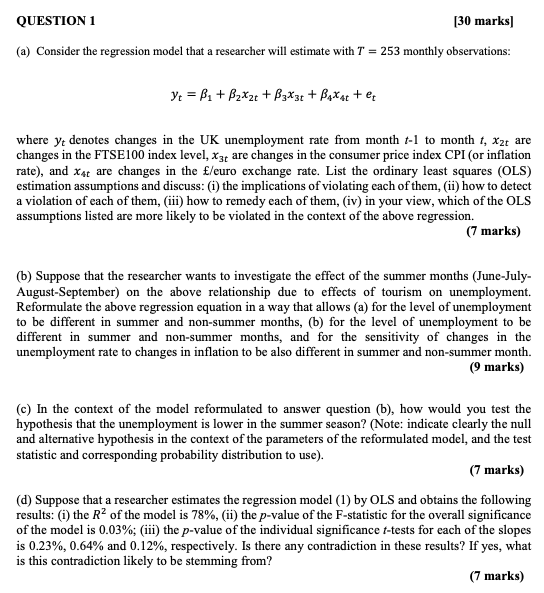QUESTION 1 [30 marks] (a) Consider the regression model that a researcher will estimate with 7' = 253 monthly observations: It = P1 + Bzxzt + Byxat + Paxar + er where y denotes changes in the UK unemployment rate from month -1 to month f, Xar are changes in the FTSE100 index level, xy; are changes in the consumer price index CPI (or inflation rate), and xat are changes in the f/euro exchange rate. List the ordinary least squares (OLS) estimation assumptions and discuss: (i) the implications of violating each of them, (ii) how to detect a violation of each of them, (iii) how to remedy each of them, (iv) in your view, which of the OLS assumptions listed are more likely to be violated in the context of the above regression. (7 marks) (b) Suppose that the researcher wants to investigate the effect of the summer months (June-July- August-September) on the above relationship due to effects of tourism on unemployment. Reformulate the above regression equation in a way that allows (a) for the level of unemployment to be different in summer and non-summer months, (b) for the level of unemployment to be different in summer and non-summer months, and for the sensitivity of changes in the unemployment rate to changes in inflation to be also different in summer and non-summer month. (9 marks) (c) In the context of the model reformulated to answer question (b), how would you test the hypothesis that the unemployment is lower in the summer season? (Note: indicate clearly the null and alternative hypothesis in the context of the parameters of the reformulated model, and the test statistic and corresponding probability distribution to use). (7 marks) (d) Suppose that a researcher estimates the regression model (1) by OLS and obtains the following results: (i) the R' of the model is 78%, (ii) the p-value of the F-statistic for the overall significance of the model is 0.03%; (iii) the p-value of the individual significance -tests for each of the slopes is 0.23%, 0.64% and 0.12%, respectively. Is there any contradiction in these results? If yes, what is this contradiction likely to be stemming from? (7 marks)







